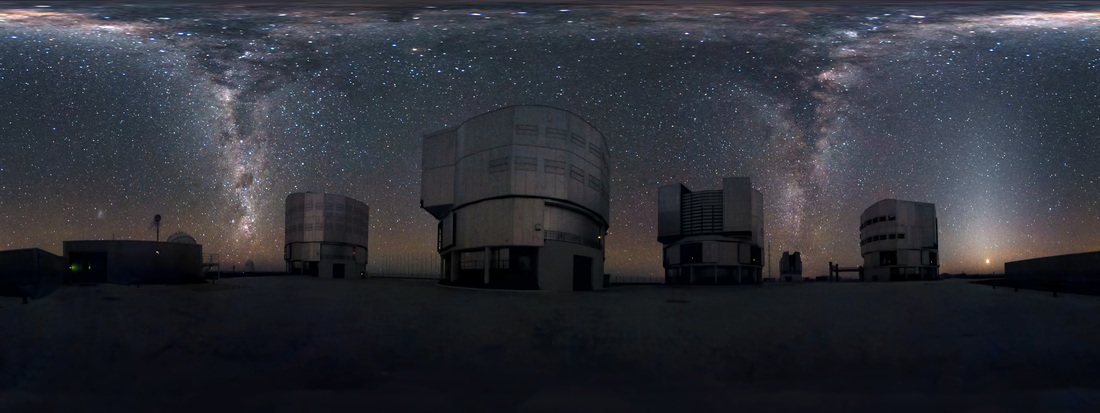Many astronomical photographs capture stunning vistas of the skies, and this is no exception. However, there’s something unusual about this panorama. Behind ESO’s (European Southern Observatory) Very Large Telescope (VLT) in Chile's Atacama Desert, two streams of stars seem to cascade down like waterfalls, or perhaps rise like smoke columns to the heavens. That’s because this panorama captures the entire dome of the sky, from the zenith down to the horizon, a full 360 degrees around. The two streams are in fact a single band: the plane of our galaxy, the Milky Way, as it arcs across the sky from horizon to horizon. As it passes overhead, it appears to spread out across the whole top edge of the panorama, due to the distortion needed to squeeze the full dome of the sky into a flat, rectangular image.
To understand the picture, imagine that the far left side is attached to the far right, creating a loop around you, and that the top edge is drawn together to a single point overhead. Thus, it encompasses the full dome of the sky above you.
On the left side of the image, the silhouette of the observatory’s windsock on its pole can be seen above the building. To the left of the windsock is the bright smudge of the Small Magellanic Cloud, a neighboring galaxy of the Milky Way. To the right, in the plane of the Milky Way, is the reddish glow of the Carina Nebula. Above that is the darkness of the Coalsack Nebula, next to the Southern Cross, and slightly higher still are the two bright stars of Alpha and Beta Centauri. The four tall buildings in the image house the 8.2-meter-diameter Unit Telescopes (UTs) of the VLT. Between the two UTs on the right is the smaller building of the VLT Survey Telescope. On the right of the image, the planet Venus glows just above the horizon.
This panorama, which shows not only the VLT on the mountaintop of Cerro Paranal, but also the beautiful sky that the observatory studies, was created by ESO Photo Ambassador Serge Brunier. Just as the VLT’s state-of-the-art technology expands our view of the Universe, Serge has used the most advanced photographic techniques to capture an entire hemisphere of the sky in one image — far more than our eyes could see in a single view.
Credits: ESO/S. Brunier
See also: http://www.space.com/21258-eso-very-large-telescope-space-photos.html
Amazing Space Views of ESO's Very Large Telescope (Photos)

 RSS Feed
RSS Feed